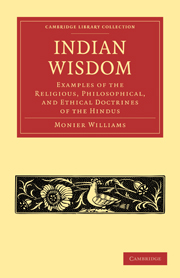Book contents
- Frontmatter
- PREFACE
- THE INDO-ROMANIC ALPHABET WITH THE EQUIVALENT SANSKṚIT LETTERS AND RULES FOR PRONUNCIATION
- Contents
- INTRODUCTION
- LECTURE I The Hymns of the Veda
- LECTURE II The Brāhmana Portion of the Veda
- LECTURE III The Systems of Philosophy
- LECTURE IV The Nyāya System of Philosophy
- LECTURE V The Sānkhya System of Philosophy
- LECTURE VI The Mimāṉsā System of Philosophy
- LECTURE VII Irregular Systems and Eclectic School
- LECTURE VIII Smṛiti. The Vedāngas
- LECTURE IX Smārta-sūtra. Gṛihya, ‘domestic rules’
- LECTURE X The Law-books. Mainu continued
- LECTURE XI Metrical Version of some of Manu's Moral and Religious Precepts
- LECTURE XII The Epic Poems
- LECTURE XIII The Mahā-bhārata
- LECTURE XIV The Epic Poems compared together and with Homer
- LECTURE XV The Artificial Poems
- INDEX
- ADDITIONS AND CORRECTIONS
- ORIENTAL WORKS
LECTURE XIV - The Epic Poems compared together and with Homer
Published online by Cambridge University Press: 29 August 2010
- Frontmatter
- PREFACE
- THE INDO-ROMANIC ALPHABET WITH THE EQUIVALENT SANSKṚIT LETTERS AND RULES FOR PRONUNCIATION
- Contents
- INTRODUCTION
- LECTURE I The Hymns of the Veda
- LECTURE II The Brāhmana Portion of the Veda
- LECTURE III The Systems of Philosophy
- LECTURE IV The Nyāya System of Philosophy
- LECTURE V The Sānkhya System of Philosophy
- LECTURE VI The Mimāṉsā System of Philosophy
- LECTURE VII Irregular Systems and Eclectic School
- LECTURE VIII Smṛiti. The Vedāngas
- LECTURE IX Smārta-sūtra. Gṛihya, ‘domestic rules’
- LECTURE X The Law-books. Mainu continued
- LECTURE XI Metrical Version of some of Manu's Moral and Religious Precepts
- LECTURE XII The Epic Poems
- LECTURE XIII The Mahā-bhārata
- LECTURE XIV The Epic Poems compared together and with Homer
- LECTURE XV The Artificial Poems
- INDEX
- ADDITIONS AND CORRECTIONS
- ORIENTAL WORKS
Summary
I PROCEED to note a few obvious points that force themselves on the attention in comparing the two great Indian Epics with each other, and with the Homeric poems. I have already stated that the episodes of the Mahā-bhārata occupy more than three-fourths of the whole poem. It is, in fact, not one poem, but a combination of many poems: not a Kāvya, like the poem of Vālmīki, by one author, but an Itihāsa by many authors. This is one great distinctive feature in comparing it with the Rāmāyaṇa. In both Epics there is a leading story, about which are collected a multitude of other stories; but in the Mahā-bhārata the main narrative only acts as a slender thread to connect together a vast mass of independent legends, and religious, moral, and political precepts; while in the Rāmāyaṇa the episodes, though numerous, never break the solid chain of one principal and paramount subject, which is ever kept in view. Moreover, in the Rāmāyaṇa there are few didactic discourses and a remarkable paucity of sententious maxims.
It should be remembered that the two Epics belong to different periods and different localities. Not only was a large part of the Mahā-bhārata composed later than the Rāmāyaṇa, parts of it being comparatively modern, but the places which gave birth to the two poems are distinct (see p. 320). Moreover, in the Rāmāyaṇa the circle of territory represented as occupied by the Āryans is more restricted than that in the Mahā-bhārata. It reaches to Videha or Mithilā and Anga in the East, to Su-rāshṭra in the South-west, to the Yamunā and great Daṇḍaka forest in the South.
- Type
- Chapter
- Information
- Indian WisdomExamples of the Religious, Philosophical, and Ethical Doctrines of the Hindus, pp. 415 - 448Publisher: Cambridge University PressPrint publication year: 2010First published in: 1875

